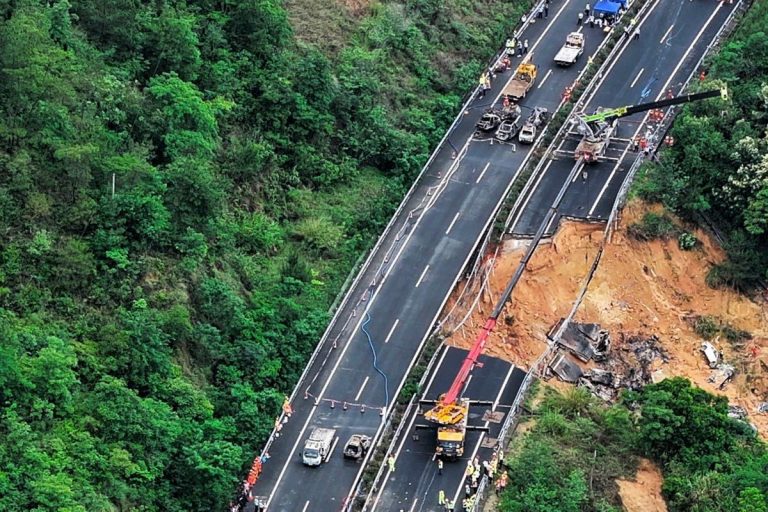In the early hours of May 1, disaster struck southeastern China when a section of a four-lane highway suddenly plummeted. The collapse, which took place in Meizhou, a city in Guangdong Province, saw 23 vehicles plunge down a steep slope. The tragedy has so far claimed 48 lives.
The calamity occurred around 2 a.m. after a month of relentless rainfall that led to catastrophic floods and saw over 110,000 people evacuated. The tragedy also took place during the city’s May Day holiday travel, which typically sees a surge in traffic as millions of Chinese travel to reunite with their families.
By May 2, the death toll could possibly reach 51 as three victims remain unidentified, pending DNA results. In addition to the fatalities, 30 individuals sustained “non-life-threatening injuries,” local media reported. During a press briefing following the incident, Meizhou city Mayor Wang Hui confirmed the nationalities of the victims and said that no foreigners were involved.
RELATED: Deadly Windstorm in China’s Jiangxi Province Exposes Major Corruption Scandal
A trail of destruction
The collapse left a stark gash in the lush forest landscape, marking a grim scene of devastation as emergency crews worked around the clock to navigate the dangerous terrain. The affected section of the highway — weakened by the recent torrential rains — succumbed to the weight of saturated soil. This caused vehicles to tumble and, in some cases, ignite upon impact.
Success
You are now signed up for our newsletter
Success
Check your email to complete sign up
Rescue efforts faced substantial obstacles due to the continued adverse weather conditions. Rain and ongoing land and gravel slides complicated the extraction of vehicles, some of which were severely burnt or crushed under massive volumes of soil.
“Because some of the vehicles involved caught fire, the difficulty of the rescue operation has increased,” said Wen Yongdeng, Communist Party secretary for the Meizhou emergency management bureau.
By Thursday morning, rescue teams, equipped with construction cranes and excavators, were working to clear a broader area on the slope. They are attempting to prevent further soil movement that could lead to more casualties, said Wen. But the saturated soil, a result of over 56 centimeters (22 inches) of rainfall in the past four weeks — more than quadruple last year’s amount in the same period — posed a significant risk for “secondary disasters,” added Wen.
“Most of the vehicles were buried in soil during the collapse, with a large volume of soil covering them,” he said, adding that the saturated soil could “make it prone to secondary disasters during the rescue process.”
This natural disaster is part of a broader pattern of extreme weather affecting Guangdong Province, which is home to more than 127 million people. Record rains and flooding, along with hail, have wreaked havoc across the region. Just last weekend, a tornado triggered by severe storms killed five people in Guangzhou, the provincial capital.
The unexpected early arrival of the rainy season this year has also led to unexpected flooding in some villages within Meizhou, exacerbating the challenges faced by local authorities and rescue teams.
RELATED: Communist Politics Are Bringing Disaster to China–And Xi Jinping
Calls for transparency
The highway collapse also coincided with the first day of a five-day national holiday in China, a time when millions are traveling, which likely increased the traffic load on the roadway. The incident has raised questions about the resilience of infrastructure in the face of increasingly frequent and severe weather events.
Following the disaster, Chinese leader Xi Jinping called for all regions to bolster their monitoring and early warning systems. He also called on higher levels of government to conduct a “thorough investigation” into potential risks to ensure public safety and maintain social stability.
But as the community mourns the loss of life and the authorities continue their search and rescue efforts, many are also criticizing the apparent lack of preparedness and infrastructure resilience that could have possibly mitigated the scale of the catastrophe. Questions are being raised about the adequacy of disaster response plans and the maintenance of critical infrastructure, especially in regions known to be susceptible to harsh weather.
“This highway collapse, with its horrific toll, is just another reminder of China’s neglect for safety and quality in their rush for development,” writes one user on X. “How many more lives must be lost, China?”













